Railroad Bridges: History, Types, Photos
Last revised: September 4, 2024
By: Adam Burns
Railroad bridges and train trestles can trace their roots back to the industry's beginnings in the mid-19th century. Prior to the development of iron, and later steel, early bridges were built of either stone or wood.
During this time engineers designed some quite stunning, and perhaps somewhat harrowing, wooden bridges that appeared as if they might not hold a person let alone a heavy train.
However, after iron and steel began to be widely employed in the latter 19th century new bridge designs were employed, the most common of these being trusses, beams, girders and spans.
Today, many of the stone-arch bridges built in the mid-19th century remain in regular service due to their exceptional construction.
Additionally, most are also either on the National Register or National Historic Landmarks with names like the Thomas Viaduct in Maryland or the Starrucca Viaduct in northeastern Pennsylvania.
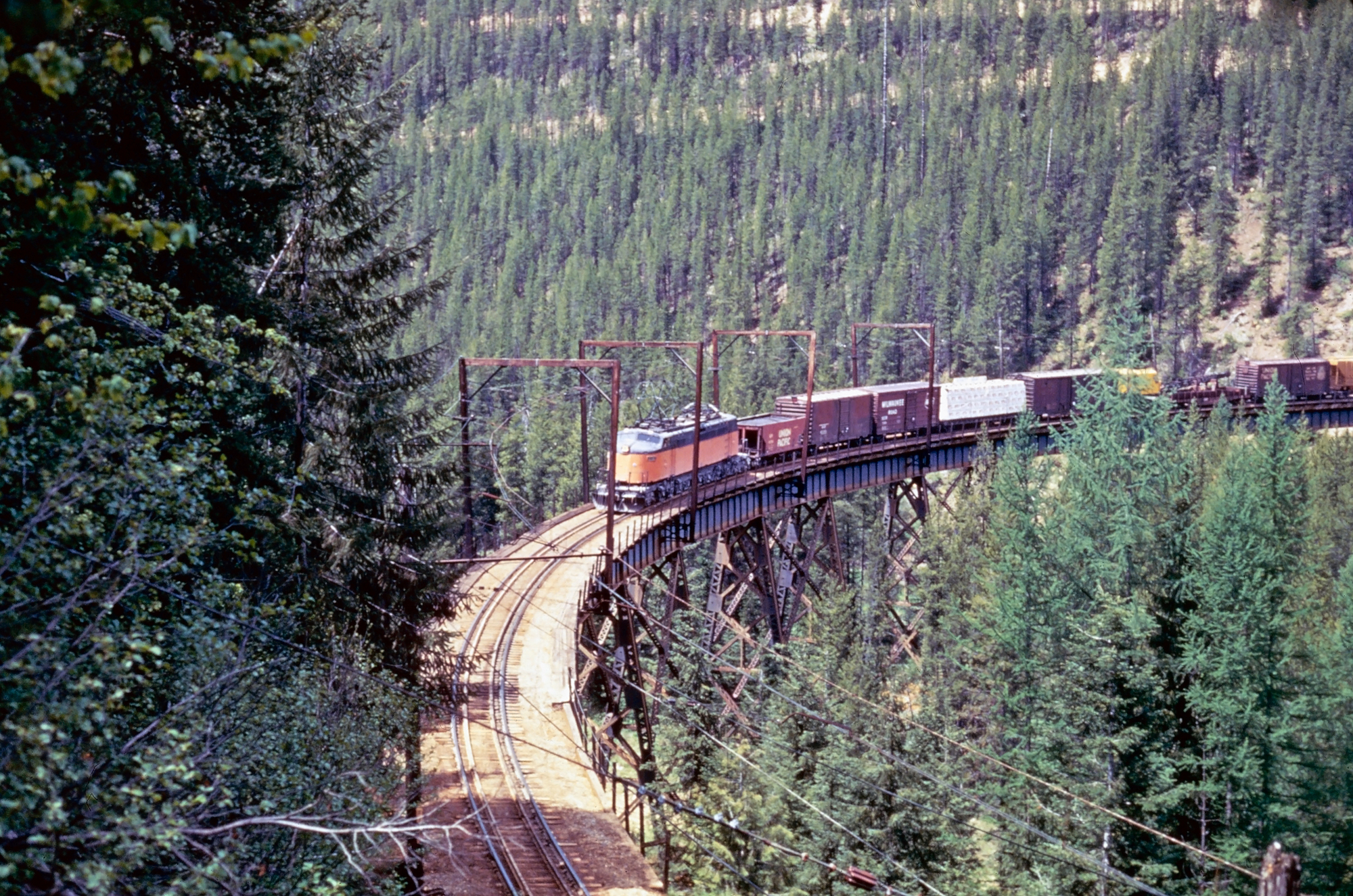 Milwaukee Road "Little Joe" E-70 crosses Dominion Creek Trestle - just east of St. Paul Pass (Montana) - with an eastbound train, circa 1973. Photographer unknown. American-Rails.com collection.
Milwaukee Road "Little Joe" E-70 crosses Dominion Creek Trestle - just east of St. Paul Pass (Montana) - with an eastbound train, circa 1973. Photographer unknown. American-Rails.com collection.One of the first railroad bridges to be built in the country is credited to the Baltimore & Ohio Railroad which constructed its Thomas Viaduct in 1835 located at Elkridge, Maryland over the Patapsco River.
The bridge gained its name for the B&O's first president, Philip E. Thomas and at the time of its construction was the world's longest masonry bridge and the first curved structure of its kind.
Even today it remains the largest bridge of its type and still carries regular freight and passenger trains to this day, a testament to the strength and longevity of not only its stone construction but also the masons who built it.
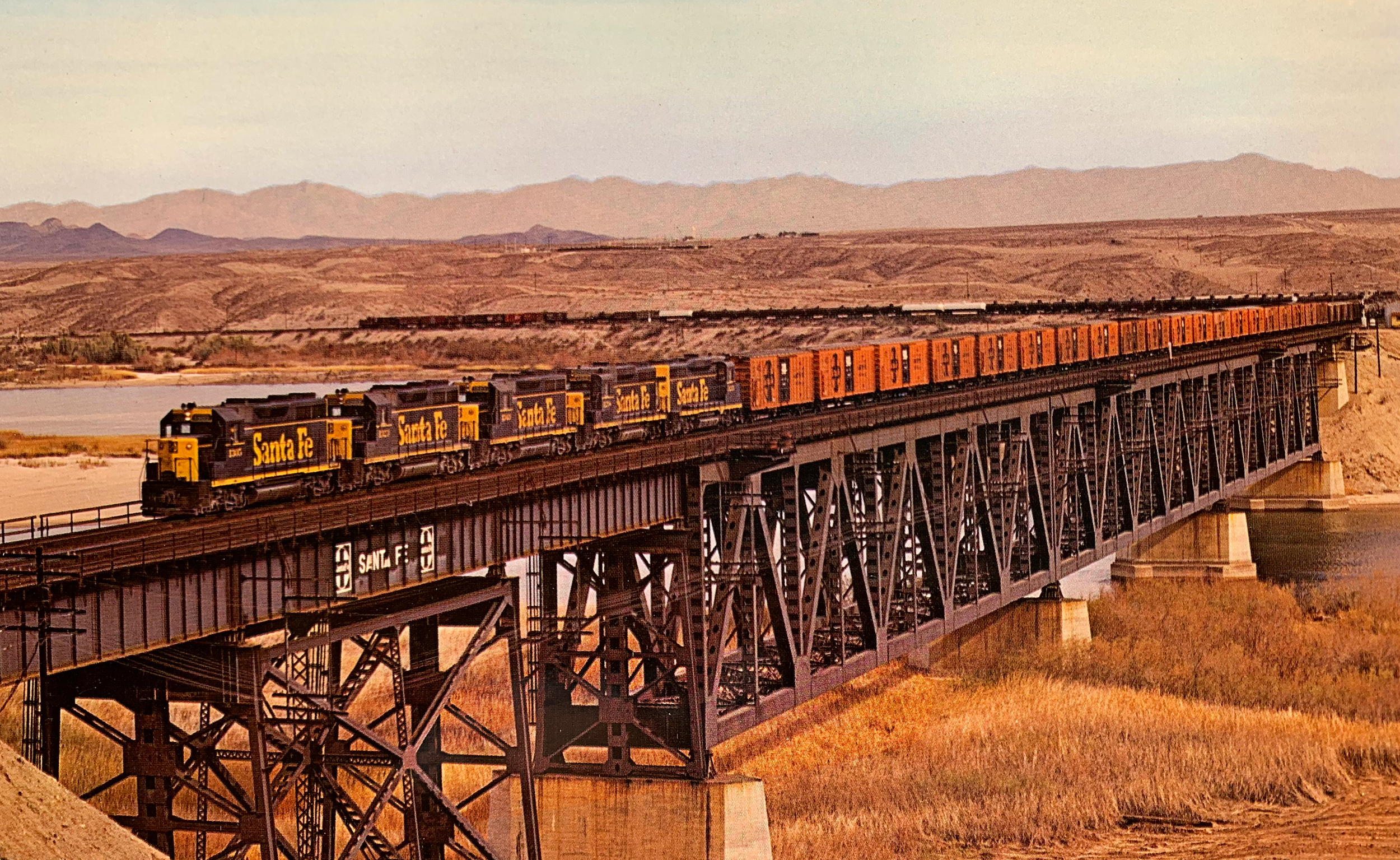 In this Santa Fe publicity photo, GP35's #1305, #1323, and #1343, along with a pair of GP30's, head west over the 1,506-foot deck-girder bridge spanning the Colorado River near rural Topock, Arizona circa 1964. Author's collection.
In this Santa Fe publicity photo, GP35's #1305, #1323, and #1343, along with a pair of GP30's, head west over the 1,506-foot deck-girder bridge spanning the Colorado River near rural Topock, Arizona circa 1964. Author's collection.Other famed stone bridges around the country include the Pennsylvania Railroad's Rockville Bridge near Harrisburg, Pennsylvania crossing the mighty Susquehanna River.
This massive structure is 3,820 feet long and includes 48 arches. it opened in 1902 and still carries Norfolk Southern Railway freight trains and Amtrak passenger trains today.
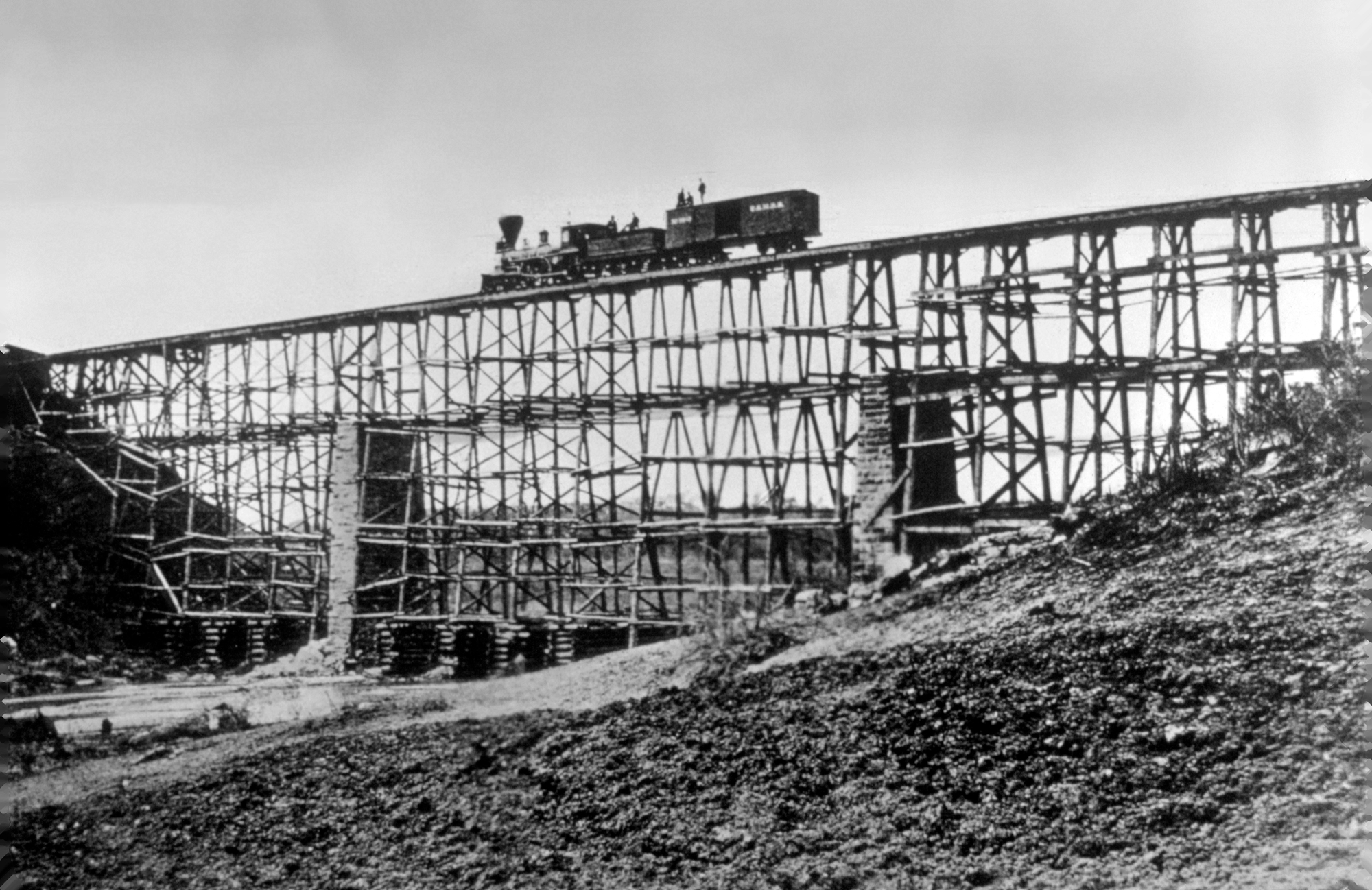 A large, wood pile bridge, constructed by the United States Military Railroad, is seen here on the Richmond, Fredericksburg & Potomac, circa 1863. Posed on the structure is the 4-4-0 "General Haupt." Such rickety bridges were quite common in this era as they were cheap and could be completed quickly. American-Rails.com collection.
A large, wood pile bridge, constructed by the United States Military Railroad, is seen here on the Richmond, Fredericksburg & Potomac, circa 1863. Posed on the structure is the 4-4-0 "General Haupt." Such rickety bridges were quite common in this era as they were cheap and could be completed quickly. American-Rails.com collection.Although not built of stone it should be noted that one of the most famous arched railroad bridges in the country is the Delaware, Lackawanna & Western Railroad's Tunkhannock Viaduct.
Topping out at 240 feet above the valley floor and roughly a half-mile long at 2,375 feet the railroad structure is a striking sight (made all the more impressive by Lackawanna R.R. located across the center arch).
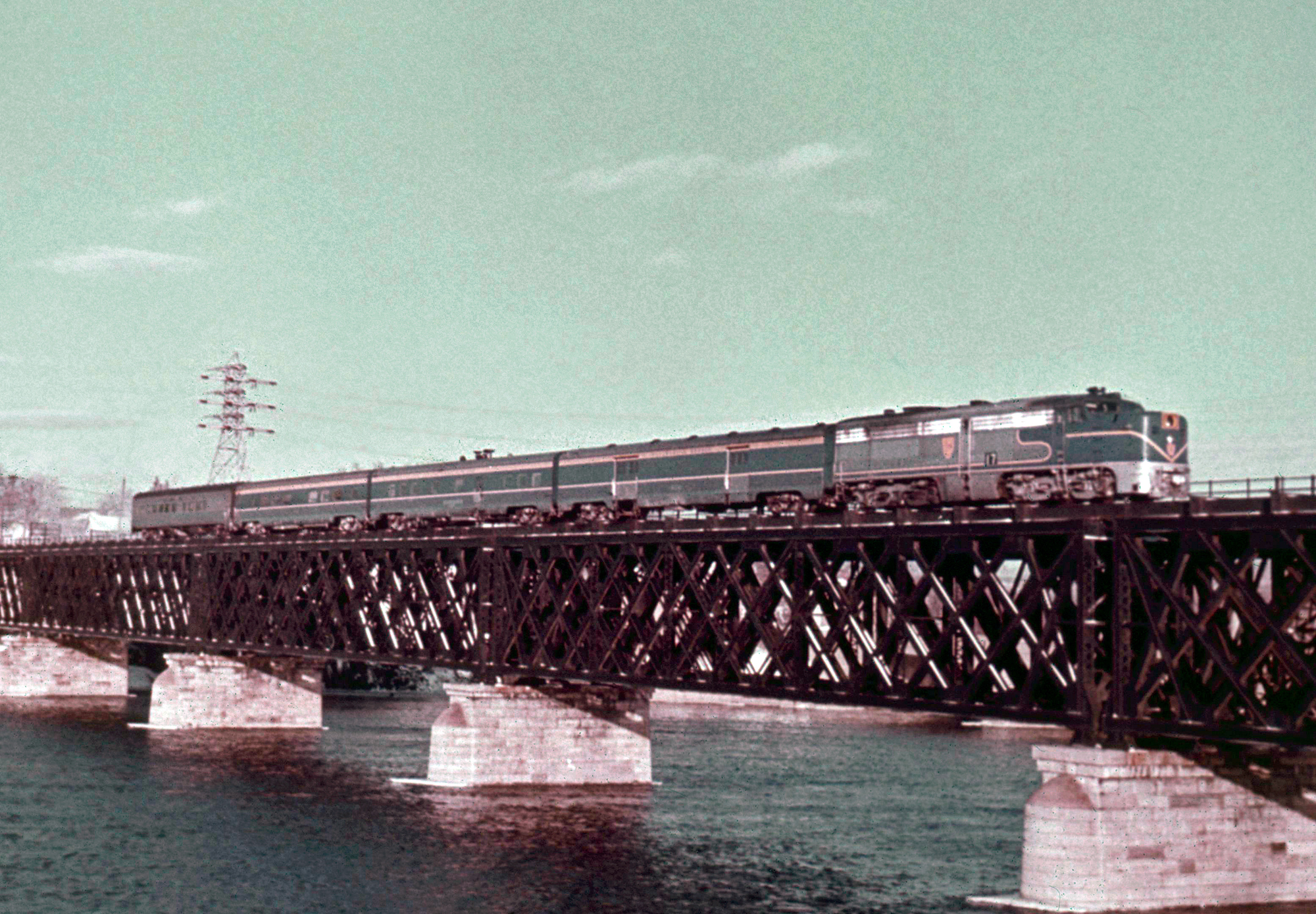 Delaware & Hudson PA-1 #17 leads the southbound "Laurentian" over the Mohawk River at Cohoes, New York during February of 1968. Jim Shaughnessy photo. American-Rails.com collection.
Delaware & Hudson PA-1 #17 leads the southbound "Laurentian" over the Mohawk River at Cohoes, New York during February of 1968. Jim Shaughnessy photo. American-Rails.com collection.While stone bridges are renowned for their overall beauty and extremely long lifespans they are also very expensive to build. To help keep expenses down early railroads began engineering railroad bridges at first from wood and later from iron once it became available.
Some of the earliest engineered railroad bridges included differing truss designs such as the Burr arch truss of 1817 and own lattice truss of 1820. One of the most common early such designs once iron was available was the Pratt truss of 1844, patented by Thomas and Caleb Pratt, and the Warren truss of 1848.
These designs can still be found on some railroad lines in the country even today (and some have or are in the process of being preserved). As steel became available in the late 1800s larger and more impressive railroad bridges were constructed.
Virtually all of these were of designs already on the books, simply differing variations of them such as the cantilever truss and through arch design, the latter of which is perhaps most recognized as railroad bridges go in the New York, New Haven & Hartford Railroad's Hell Gate Bridge which connects Queens and Manhattan over the East River.
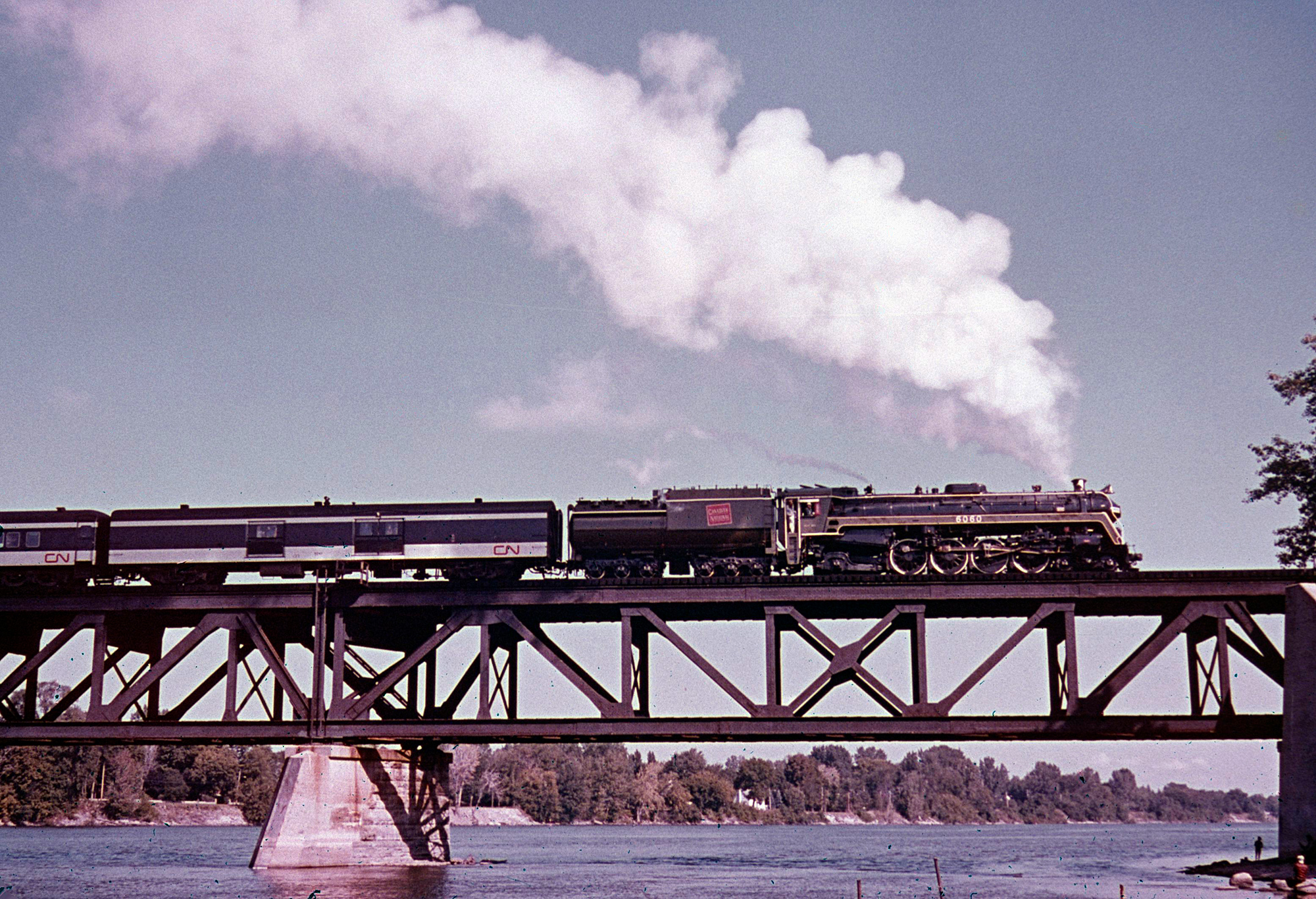 Canadian National 4-8-2 #6060 leads an excursion eastbound over the historic Pratt Deck Truss bridge spanning the Richelieu River at Beloeil, Quebec on September 15, 1973. Carl Sturner photo. American-Rails.com collection.
Canadian National 4-8-2 #6060 leads an excursion eastbound over the historic Pratt Deck Truss bridge spanning the Richelieu River at Beloeil, Quebec on September 15, 1973. Carl Sturner photo. American-Rails.com collection.This impressive structure was completed in September 1916 and remains an important artery for Amtrak and freight trains today. The most common railroad bridges are probably variations of the span plate girder designs. These bridges typically only span small streams, cuts or open areas and are relatively cheap and inexpensive to build.
However, even some longer railroad bridges will be partially constructed of the span or girder design, it simply depends on how the engineer has drawn up the plans for a particular structure. For an excellent general overview of common railroad bridge designs please click here.
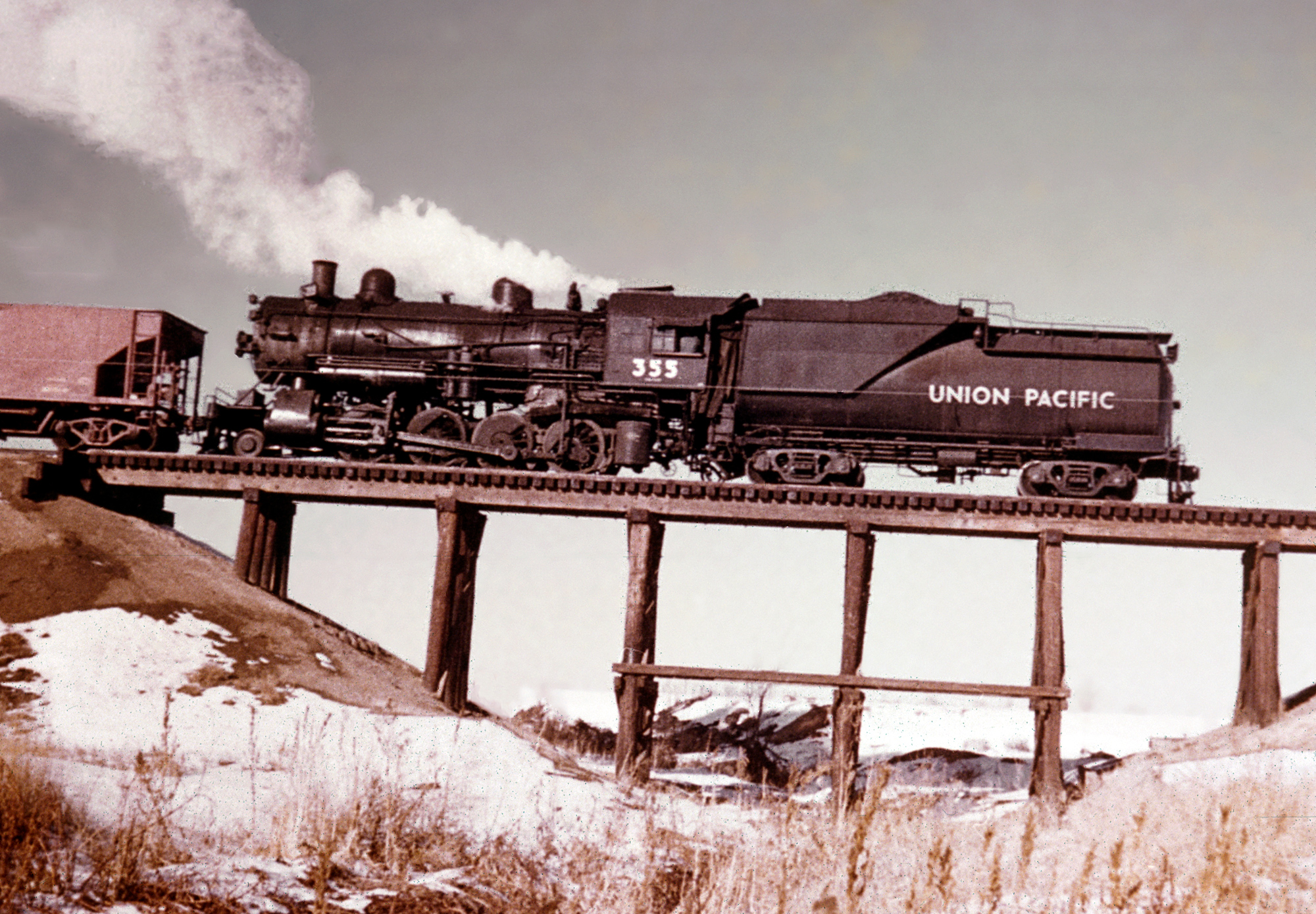 Union Pacific 2-8-0 #355 works local service on the Crow Valley Branch near Greeley, Colorado as the locomotive crosses a small, wood pile bridge in November, 1956. Such structures were once a common and cheap way to span two points, although not necessarily the most structurally sound when wood was utilized. American-Rails.com collection.
Union Pacific 2-8-0 #355 works local service on the Crow Valley Branch near Greeley, Colorado as the locomotive crosses a small, wood pile bridge in November, 1956. Such structures were once a common and cheap way to span two points, although not necessarily the most structurally sound when wood was utilized. American-Rails.com collection.Railroad bridges will forever be an important component of the railroad infrastructure which allows trains to cross the country because obviously without them we could never have spanned the smallest stream to largest valley.
It should also be mentioned that several bridges are nearing the end of their useful lifespan and will need to be replaced soon (or already have been). Obviously, it is necessary that these bridges are rebuilt sooner rather than later not only to keep an accident from happening but also to keep the flow of goods back and forth across the country.
So, when state or federal money is being authorized to help in the building of a private, new bridge it is certainly going towards a worthy cause and is not a waste of tax dollars as these structures are very expensive to construct, even for large railroads (several million dollars per bridge is common these days).
Recent Articles
-
Alabama's - Wine Tasting - Train Rides
Jan 10, 26 09:29 AM
While the state might not be the first to come to mind when one thinks of wine or train travel, the unique concept of wine tasting trains adds a refreshing twist to the Alabama tourism scene. -
Maryland Dinner Train Rides At WMSR!
Jan 10, 26 09:13 AM
The Western Maryland Scenic Railroad (WMSR) has become one of the Mid-Atlantic’s signature heritage operations—equal parts mountain railroad, living museum, and “special-occasion” night out. -
Arkansas Dinner Train Rides On The A&M!
Jan 10, 26 09:11 AM
If you want a railroad experience that feels equal parts “working short line” and “time machine,” the Arkansas & Missouri Railroad (A&M) delivers in a way few modern operations can. -
South Dakota's - Murder Mystery - Dinner Train Rides
Jan 10, 26 09:08 AM
While the state currently does not offer any murder mystery dinner train rides, the popular "1880 Train" at the Black Hills Central recently hosted these popular trips! -
Wisconsin's - Murder Mystery - Dinner Train Rides
Jan 10, 26 09:07 AM
Whether you're a fan of mystery novels or simply relish a night of theatrical entertainment, Wisconsin's murder mystery dinner trains promise an unforgettable adventure. -
Missouri's - Murder Mystery - Dinner Train Rides
Jan 10, 26 09:05 AM
Missouri, with its rich history and scenic landscapes, is home to one location hosting these unique excursion experiences. -
Washington ~ Murder Mystery ~ Dinner Train Rides
Jan 10, 26 09:04 AM
This article delves into what makes murder mystery dinner train rides in Washington State such a captivating experience. -
Kentucky Scenic Train Rides At KRM!
Jan 09, 26 11:13 PM
Located in the small town of New Haven the Kentucky Railway Museum offers a combination of historic equipment and popular excursions. -
Washington "Wine Tasting" Train Rides
Jan 09, 26 08:53 PM
Here’s a detailed look at where and how to ride, what to expect, and practical tips to make the most of wine tasting by rail in Washington. -
Kentucky's - Wine Tasting - Train Rides
Jan 09, 26 08:21 PM
Kentucky, often celebrated for its rolling pastures, thoroughbred horses, and bourbon legacy, has been cultivating another gem in its storied landscapes; enjoying wine by rail. -
Kentucky's - Murder Mystery - Dinner Train Rides
Jan 09, 26 01:12 PM
In the realm of unique travel experiences, Kentucky offers an enchanting twist that entices both locals and tourists alike: murder mystery dinner train rides. -
Utah's - Murder Mystery - Dinner Train Rides
Jan 09, 26 01:05 PM
This article highlights the murder mystery dinner trains currently avaliable in the state of Utah! -
North Carolina Dinner Train Rides At NCTM!
Jan 09, 26 12:51 PM
Tucked into the Piedmont town of Spencer, the North Carolina Transportation Museum is the kind of place that feels less like a typical museum and more like a living rail yard that never quite stopped… -
Tennessee Dinner Train Rides At The TVRM!
Jan 09, 26 12:39 PM
Tucked into East Chattanooga, the Tennessee Valley Railroad Museum (TVRM) is less a “museum you walk through” and more a railroad you step aboard. -
New York Scenic Train Rides On The A&A!
Jan 09, 26 11:20 AM
The A&A is both a common-carrier short line moving freight and a heritage railroad hosting popular excursion trains, all on the same storied right-of-way. -
Pennsylvania Scenic Train Rides In Hollidaysburg!
Jan 09, 26 11:14 AM
Tucked into the Juniata River valley just south of Altoona, the Everett Railroad offers one of the most approachable—and photogenic—heritage-rail experiences in Pennsylvania -
Montana Dinner Train Rides Near Lewistown!
Jan 08, 26 03:03 PM
The Charlie Russell Chew Choo turns an ordinary rail trip into an evening event: scenery, storytelling, live entertainment, and a hearty dinner served as the train rumbles across trestles and into a t… -
Alabama's - Murder Mystery - Dinner Train Rides
Jan 08, 26 02:19 PM
There is currently one location in the state offering a murder mystery dinner experience, the Wales West Light Railway! -
Rhode Island's - Murder Mystery - Dinner Train Rides
Jan 08, 26 01:43 PM
Let's dive into the enigmatic world of murder mystery dinner train rides in Rhode Island, where each journey promises excitement, laughter, and a challenge for your inner detective. -
Florida's - Wine Tasting - Train Rides
Jan 08, 26 01:13 PM
Wine by train not only showcases the beauty of Florida's lesser-known regions but also celebrate the growing importance of local wineries and vineyards.


















